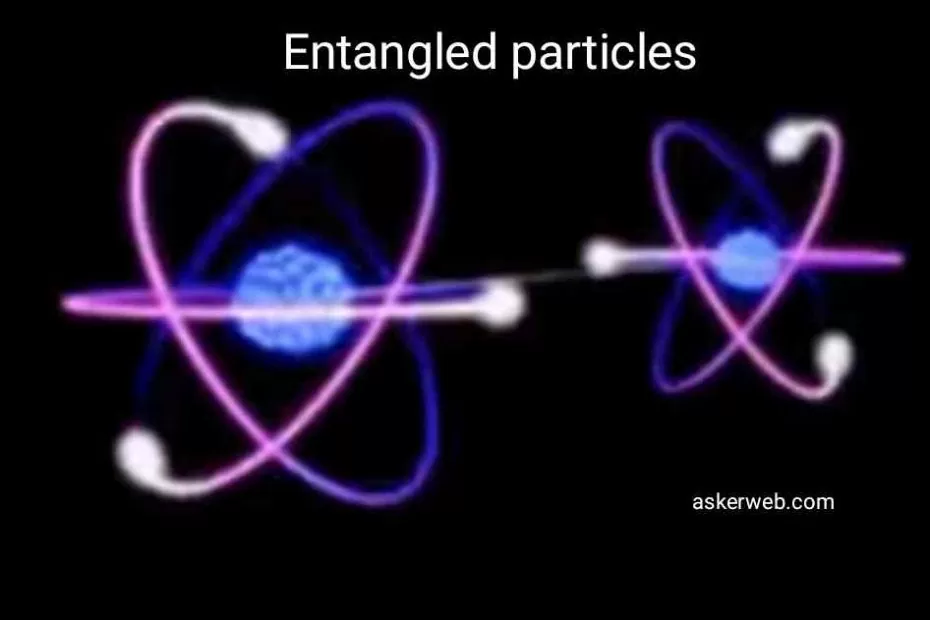Quantum Entanglement: Spooky action at a distance. Today askerweb.com will let you know what is Quantum Entanglement: If two quantum particles are entangled, in spite of being a very long distance from each other, they can communicate or share information in just a moment, that time can be so less than the transfer speed of information can overtake the speed of light which directly violates one of the main postulates of Einstein’s Theory of Relativity,” Nothing in this universe has speed faster than light.”

Veritasium
Table of Contents
The debate between Albert Einstein & Niels Bohr:
However, between Albert Einstein and Niels Bohr, there was a debate. in fact, Einstein in his whole life did not agree with the weird prediction of Quantum physics. He didn’t agree with Niels Bohr.
According to Einstein, every object in this universe has a fixed state in reality irrespective of the fact we watch it or not. In the classical universe, all objects and all phenomena can be explained with this conclusion. For example, if we see in space, there are many stars or planets out of our observable universe, we till now didn’t explore. That doesn’t mean they don’t exist- this was according to Einstein.

Now, come to Bohr’s point. He believed in the ‘Superposition Principal’. He gave Copenhagen interpretation in 1920. According to him, we can define or describe an object’s state only after seeing it. Because it’s the time when it becomes well-defined. Before we look at it, it has only wave property, which is not well-defined. It can have any form or state which is not predefined and predetermined. It’s called the object’s ‘Superposition State’.
Example of superposition state:
QuantumVisions Physikdidaktik WWU Münster
According to Quantum physics, by Stern-Gerlach experiment, we can conclude that every Quantum object has an intrinsic property, that’s called spin. This spin doesn’t mean it’s spinning with respect to any axis or moving around any other object. This spin is related to particles’ angular momentum. In simple words, an electron in the atom and at its sub-shell may have up-spin or down-spin. But if it’s not seeing, according to the Superposition Principle, it has two properties (up-spin and down-spin) at the same time.
Science ABC
Science ABC
Is tossing of coin an example of superposition state?

No, absolutely not. If we think that tossing a coin is an example of a superposition state because as long as it’s in the air, we don’t know whether we shall get head or tail. But it’s not so simple. There are some reasons.
- We are watching it. But according to Superposition Principle as soon as we keep our eyes on it, its not-well-defined wave nature collapses and it has a perfect well-defined state.
- It has two possibilities and those are predefined. I mean to say that it has a head at its one side and a tail at its other side irrespective of our watching. But that shouldn’t be in the case of Superposition State
Again let’s come to Quantum entanglement.
Entangled particles have two properties-
- Entangled particles follow the conservation of angular momentum.
- Measuring one particle leads to the collapse of the wave function of another particle in spite of being at a very distance, i.e. irrespective of distance.
But, how is it possible? That means if two particles are at two corners of this massive universe and we do something on a particle, another particle will be affected at that moment. The speed of the transfer of the signal from the affected (by us) particle to the receiver particle can be greater than the speed of light.
Albert Einstein said it “Spooky action at distance” and with two other Scientists Albert Einstein, Boris Podolsky, and Nathan Rosen (EPR) named it as EPR paradox or Quantum Entanglement Paradox.
But what is the reason for this EPR paradox?
With matter in our universe, there is a vast amount of antimatter. And according to some Physicists, this antimatter is the reason for this Quantum Entanglement.

For example, the electron is an oppositely charged particle of the positron. And if two opposite particles collide, a high amount of energy releases, this process is called “Annihilation”. If electron and positron come in contact, two become annihilated and two photons emitted in the form of high-frequency gamma rays. Now, as I have told before about the“Spin”, which suggests the “conservation of angular momentum”, which is called “Spin angular momentum“ (There are two types of angular momentum in quantum mechanics, one is orbital angular momentum and the second one is spin angular momentum, after coupling of these two angular momentums, total angular momentum creates, which is very important in Anomalous Zeeman effect). To understand this, take the spin of the 1st photon as (+1/2), then to conserve the spin angular momentum spin of the second photon becomes (-1/2).
Now, where is the concept of Quantum Entanglement and Superposition state in this example?
As the photons are in a superposition state, we can not find out the exact state (up or down, i.e. +1/2 or -1/2) of any photon, which means 1st photon is in up spin and down spin at the same time.
As soon as we observe any photon or measure its spin its wave function collapses and it becomes only up spin or down spin. Now, at that same moment according to Quantum Entanglement wave function of another photon also collapses and its spin also becomes only down or up (absolutely opposite of the previous photon). This process is so fast that we can say “Quantum Entanglement” is an “instantaneous process”.
If the process is so fast, is the speed more than the speed of light? In fact, Does Entanglement violate relativity?
Do comment below, if you know.






